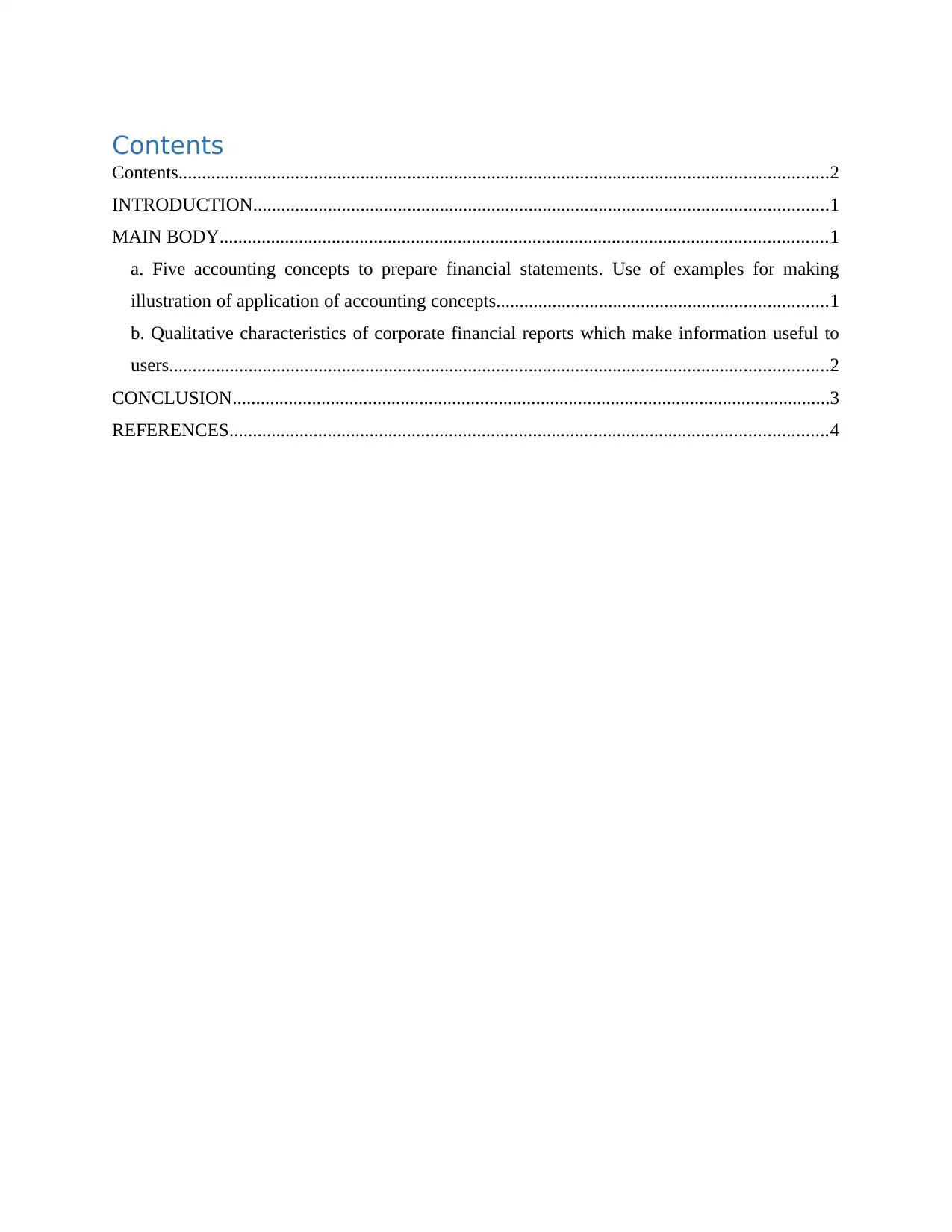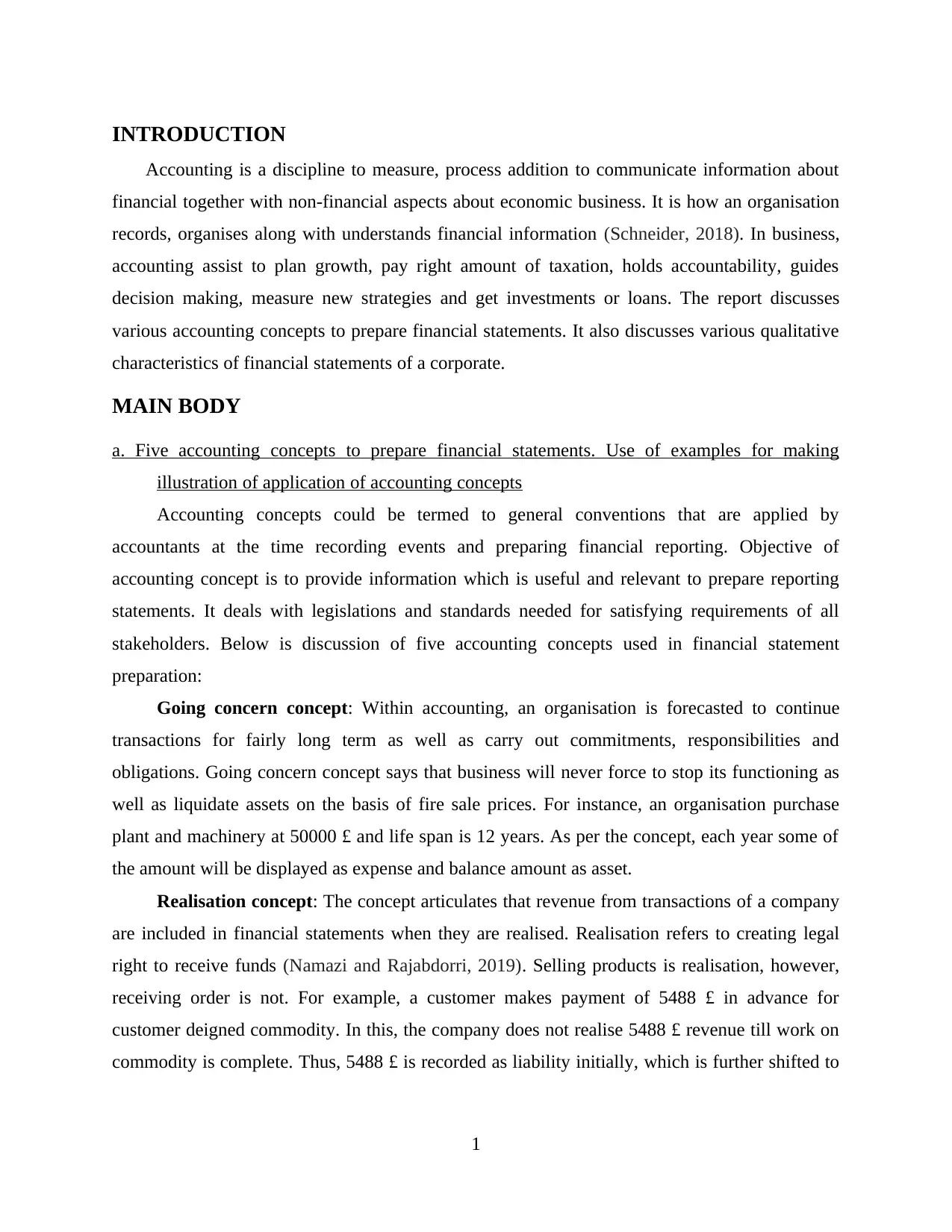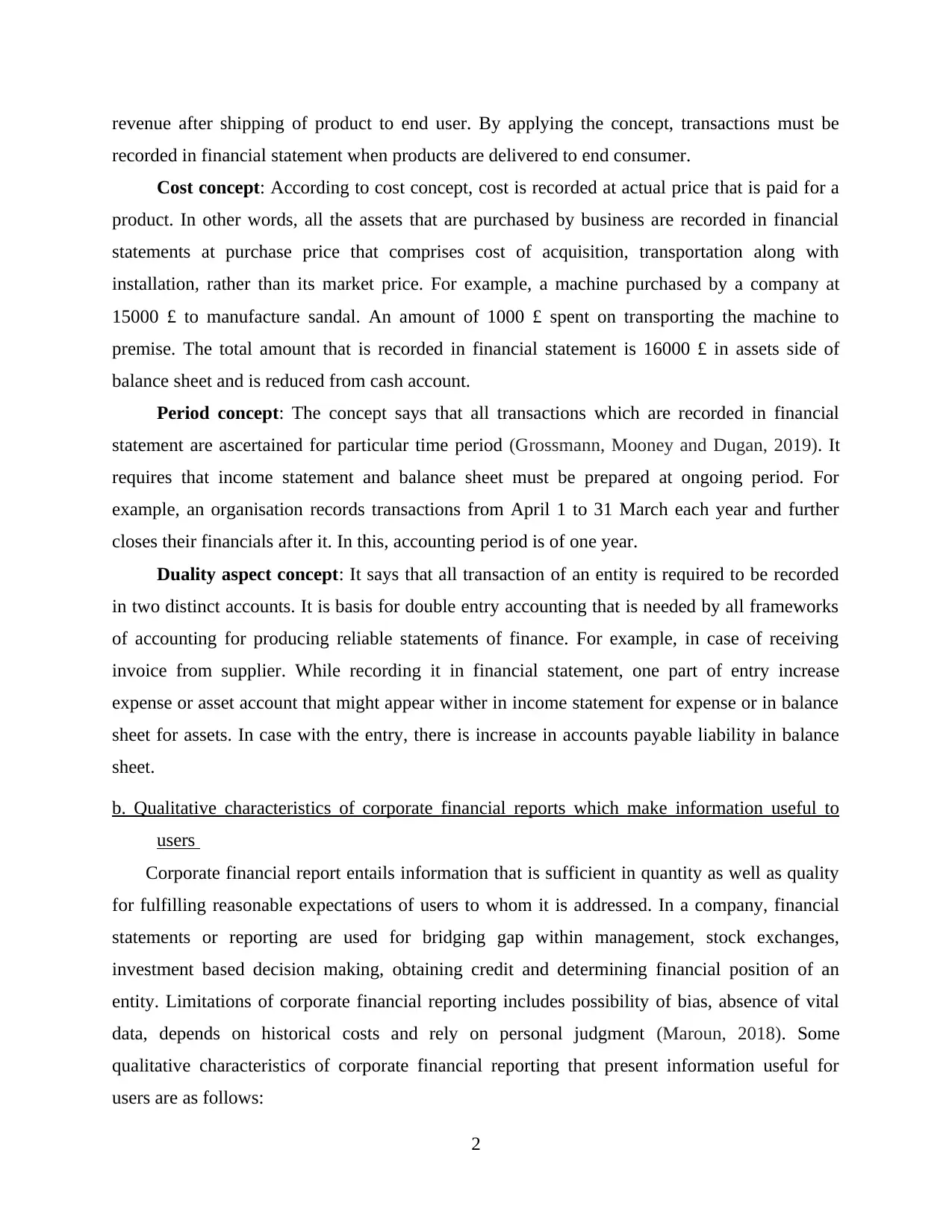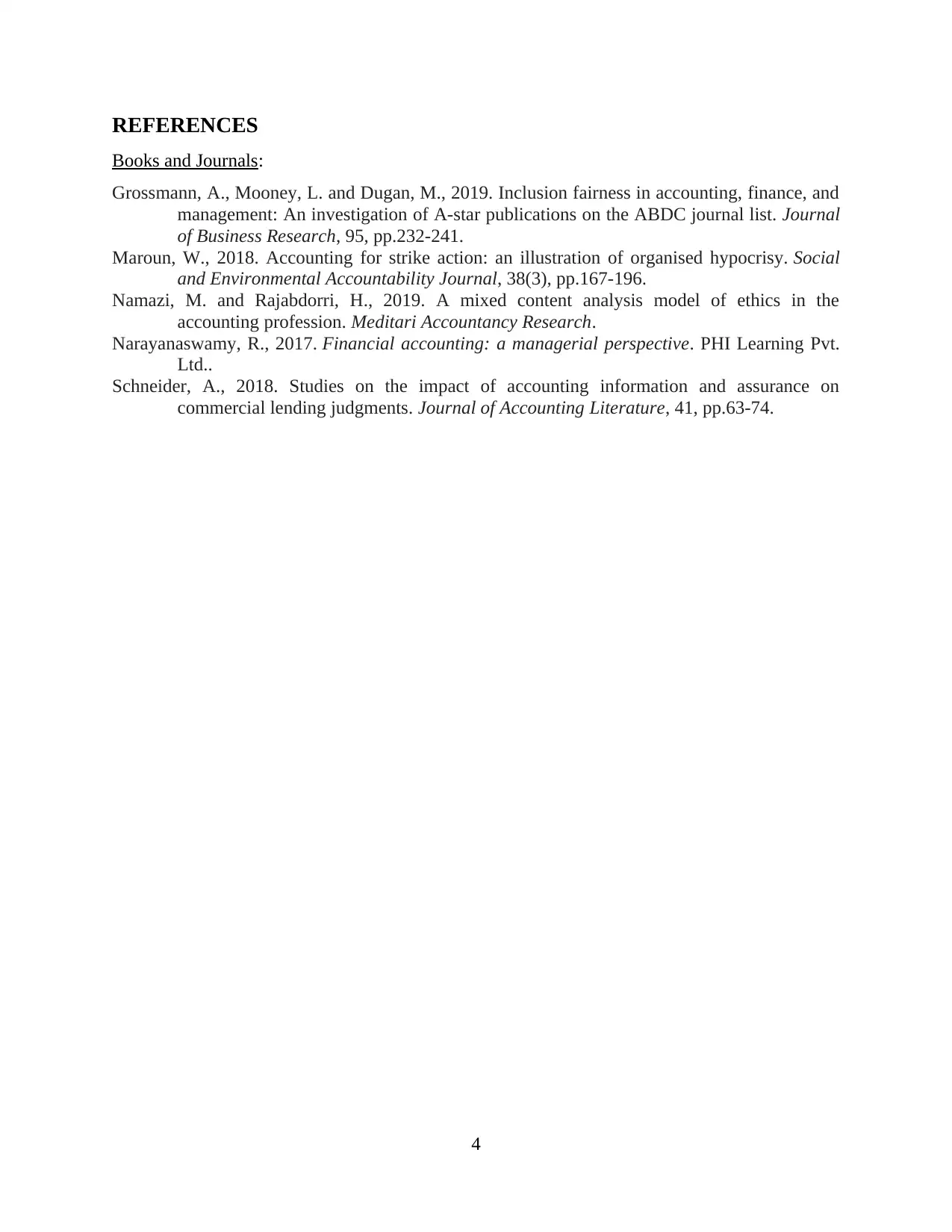Accounting Concepts Application and Corporate Financial Reporting
VerifiedAdded on 2023/06/18
|6
|1364
|295
Report
AI Summary
This report provides an overview of essential accounting concepts used in preparing financial statements, including the going concern concept, realization concept, cost concept, period concept, and duality aspect concept. It illustrates these concepts with practical examples. Additionally, the report discusses the qualitative characteristics of corporate financial reports, such as relevance, understandability, verifiability, and comparability, which enhance the usefulness of financial information for various stakeholders. It also acknowledges the limitations of corporate financial reporting, including potential biases and reliance on historical costs. Desklib offers a wide range of solved assignments and study resources for students.

Individual projects
accounting for business
accounting for business
Paraphrase This Document
Need a fresh take? Get an instant paraphrase of this document with our AI Paraphraser

Contents
Contents...........................................................................................................................................2
INTRODUCTION...........................................................................................................................1
MAIN BODY..................................................................................................................................1
a. Five accounting concepts to prepare financial statements. Use of examples for making
illustration of application of accounting concepts.......................................................................1
b. Qualitative characteristics of corporate financial reports which make information useful to
users.............................................................................................................................................2
CONCLUSION................................................................................................................................3
REFERENCES................................................................................................................................4
Contents...........................................................................................................................................2
INTRODUCTION...........................................................................................................................1
MAIN BODY..................................................................................................................................1
a. Five accounting concepts to prepare financial statements. Use of examples for making
illustration of application of accounting concepts.......................................................................1
b. Qualitative characteristics of corporate financial reports which make information useful to
users.............................................................................................................................................2
CONCLUSION................................................................................................................................3
REFERENCES................................................................................................................................4

INTRODUCTION
Accounting is a discipline to measure, process addition to communicate information about
financial together with non-financial aspects about economic business. It is how an organisation
records, organises along with understands financial information (Schneider, 2018). In business,
accounting assist to plan growth, pay right amount of taxation, holds accountability, guides
decision making, measure new strategies and get investments or loans. The report discusses
various accounting concepts to prepare financial statements. It also discusses various qualitative
characteristics of financial statements of a corporate.
MAIN BODY
a. Five accounting concepts to prepare financial statements. Use of examples for making
illustration of application of accounting concepts
Accounting concepts could be termed to general conventions that are applied by
accountants at the time recording events and preparing financial reporting. Objective of
accounting concept is to provide information which is useful and relevant to prepare reporting
statements. It deals with legislations and standards needed for satisfying requirements of all
stakeholders. Below is discussion of five accounting concepts used in financial statement
preparation:
Going concern concept: Within accounting, an organisation is forecasted to continue
transactions for fairly long term as well as carry out commitments, responsibilities and
obligations. Going concern concept says that business will never force to stop its functioning as
well as liquidate assets on the basis of fire sale prices. For instance, an organisation purchase
plant and machinery at 50000 £ and life span is 12 years. As per the concept, each year some of
the amount will be displayed as expense and balance amount as asset.
Realisation concept: The concept articulates that revenue from transactions of a company
are included in financial statements when they are realised. Realisation refers to creating legal
right to receive funds (Namazi and Rajabdorri, 2019). Selling products is realisation, however,
receiving order is not. For example, a customer makes payment of 5488 £ in advance for
customer deigned commodity. In this, the company does not realise 5488 £ revenue till work on
commodity is complete. Thus, 5488 £ is recorded as liability initially, which is further shifted to
1
Accounting is a discipline to measure, process addition to communicate information about
financial together with non-financial aspects about economic business. It is how an organisation
records, organises along with understands financial information (Schneider, 2018). In business,
accounting assist to plan growth, pay right amount of taxation, holds accountability, guides
decision making, measure new strategies and get investments or loans. The report discusses
various accounting concepts to prepare financial statements. It also discusses various qualitative
characteristics of financial statements of a corporate.
MAIN BODY
a. Five accounting concepts to prepare financial statements. Use of examples for making
illustration of application of accounting concepts
Accounting concepts could be termed to general conventions that are applied by
accountants at the time recording events and preparing financial reporting. Objective of
accounting concept is to provide information which is useful and relevant to prepare reporting
statements. It deals with legislations and standards needed for satisfying requirements of all
stakeholders. Below is discussion of five accounting concepts used in financial statement
preparation:
Going concern concept: Within accounting, an organisation is forecasted to continue
transactions for fairly long term as well as carry out commitments, responsibilities and
obligations. Going concern concept says that business will never force to stop its functioning as
well as liquidate assets on the basis of fire sale prices. For instance, an organisation purchase
plant and machinery at 50000 £ and life span is 12 years. As per the concept, each year some of
the amount will be displayed as expense and balance amount as asset.
Realisation concept: The concept articulates that revenue from transactions of a company
are included in financial statements when they are realised. Realisation refers to creating legal
right to receive funds (Namazi and Rajabdorri, 2019). Selling products is realisation, however,
receiving order is not. For example, a customer makes payment of 5488 £ in advance for
customer deigned commodity. In this, the company does not realise 5488 £ revenue till work on
commodity is complete. Thus, 5488 £ is recorded as liability initially, which is further shifted to
1
⊘ This is a preview!⊘
Do you want full access?
Subscribe today to unlock all pages.

Trusted by 1+ million students worldwide

revenue after shipping of product to end user. By applying the concept, transactions must be
recorded in financial statement when products are delivered to end consumer.
Cost concept: According to cost concept, cost is recorded at actual price that is paid for a
product. In other words, all the assets that are purchased by business are recorded in financial
statements at purchase price that comprises cost of acquisition, transportation along with
installation, rather than its market price. For example, a machine purchased by a company at
15000 £ to manufacture sandal. An amount of 1000 £ spent on transporting the machine to
premise. The total amount that is recorded in financial statement is 16000 £ in assets side of
balance sheet and is reduced from cash account.
Period concept: The concept says that all transactions which are recorded in financial
statement are ascertained for particular time period (Grossmann, Mooney and Dugan, 2019). It
requires that income statement and balance sheet must be prepared at ongoing period. For
example, an organisation records transactions from April 1 to 31 March each year and further
closes their financials after it. In this, accounting period is of one year.
Duality aspect concept: It says that all transaction of an entity is required to be recorded
in two distinct accounts. It is basis for double entry accounting that is needed by all frameworks
of accounting for producing reliable statements of finance. For example, in case of receiving
invoice from supplier. While recording it in financial statement, one part of entry increase
expense or asset account that might appear wither in income statement for expense or in balance
sheet for assets. In case with the entry, there is increase in accounts payable liability in balance
sheet.
b. Qualitative characteristics of corporate financial reports which make information useful to
users
Corporate financial report entails information that is sufficient in quantity as well as quality
for fulfilling reasonable expectations of users to whom it is addressed. In a company, financial
statements or reporting are used for bridging gap within management, stock exchanges,
investment based decision making, obtaining credit and determining financial position of an
entity. Limitations of corporate financial reporting includes possibility of bias, absence of vital
data, depends on historical costs and rely on personal judgment (Maroun, 2018). Some
qualitative characteristics of corporate financial reporting that present information useful for
users are as follows:
2
recorded in financial statement when products are delivered to end consumer.
Cost concept: According to cost concept, cost is recorded at actual price that is paid for a
product. In other words, all the assets that are purchased by business are recorded in financial
statements at purchase price that comprises cost of acquisition, transportation along with
installation, rather than its market price. For example, a machine purchased by a company at
15000 £ to manufacture sandal. An amount of 1000 £ spent on transporting the machine to
premise. The total amount that is recorded in financial statement is 16000 £ in assets side of
balance sheet and is reduced from cash account.
Period concept: The concept says that all transactions which are recorded in financial
statement are ascertained for particular time period (Grossmann, Mooney and Dugan, 2019). It
requires that income statement and balance sheet must be prepared at ongoing period. For
example, an organisation records transactions from April 1 to 31 March each year and further
closes their financials after it. In this, accounting period is of one year.
Duality aspect concept: It says that all transaction of an entity is required to be recorded
in two distinct accounts. It is basis for double entry accounting that is needed by all frameworks
of accounting for producing reliable statements of finance. For example, in case of receiving
invoice from supplier. While recording it in financial statement, one part of entry increase
expense or asset account that might appear wither in income statement for expense or in balance
sheet for assets. In case with the entry, there is increase in accounts payable liability in balance
sheet.
b. Qualitative characteristics of corporate financial reports which make information useful to
users
Corporate financial report entails information that is sufficient in quantity as well as quality
for fulfilling reasonable expectations of users to whom it is addressed. In a company, financial
statements or reporting are used for bridging gap within management, stock exchanges,
investment based decision making, obtaining credit and determining financial position of an
entity. Limitations of corporate financial reporting includes possibility of bias, absence of vital
data, depends on historical costs and rely on personal judgment (Maroun, 2018). Some
qualitative characteristics of corporate financial reporting that present information useful for
users are as follows:
2
Paraphrase This Document
Need a fresh take? Get an instant paraphrase of this document with our AI Paraphraser

Relevance: Corporate financial reports has feature of relevance as they comprise
information having potential to influence decisions of users through evaluating of past, present as
well as future transactions or correcting their historical evaluations. Thus, financial statements
are relevant when they provide information to user related to past events and assist them to make
predictions about upcoming events so to deal with possible uncertainties.
Understandability: It refers to extent to which recorded or presented information is
understood by users. In present era, corporate financial reporting is in excess of 100 pages
having important qualitative information. In this, information which is understandable to user of
reporting is highly desirable. In other words, information provided by financial reporting of
company requires to be readily understandable by users for perceiving its significance.
Verifiability: It is said to extent in which presented information is reproducible provided
same assumptions and data (Narayanaswamy, 2017). It is characteristic of financial statement
that they are easily verified by users on the basis of similar assumptions and information.
Comparability: It defines that an individual should be able to compare corporate
financial statement over time as well as relative to other businesses for assessing relative
financial position along with performance. All financial statements include current year
statements, comprehensive income statement addition to statement about position of finance that
are easily comparable.
CONCLUSION
The report of accounting for business concluded that process of accounting is based on
summarising, analysing and reporting transactions to oversight regulators, tax collection
companies and agencies. Accounting concepts for the purpose to prepare financial statements are
going concern concept, realisation concept, cost concept, period concept and duality aspect
concept. Key characteristics of corporate financial reports are relevance, understandability,
verifiability and comparability.
3
information having potential to influence decisions of users through evaluating of past, present as
well as future transactions or correcting their historical evaluations. Thus, financial statements
are relevant when they provide information to user related to past events and assist them to make
predictions about upcoming events so to deal with possible uncertainties.
Understandability: It refers to extent to which recorded or presented information is
understood by users. In present era, corporate financial reporting is in excess of 100 pages
having important qualitative information. In this, information which is understandable to user of
reporting is highly desirable. In other words, information provided by financial reporting of
company requires to be readily understandable by users for perceiving its significance.
Verifiability: It is said to extent in which presented information is reproducible provided
same assumptions and data (Narayanaswamy, 2017). It is characteristic of financial statement
that they are easily verified by users on the basis of similar assumptions and information.
Comparability: It defines that an individual should be able to compare corporate
financial statement over time as well as relative to other businesses for assessing relative
financial position along with performance. All financial statements include current year
statements, comprehensive income statement addition to statement about position of finance that
are easily comparable.
CONCLUSION
The report of accounting for business concluded that process of accounting is based on
summarising, analysing and reporting transactions to oversight regulators, tax collection
companies and agencies. Accounting concepts for the purpose to prepare financial statements are
going concern concept, realisation concept, cost concept, period concept and duality aspect
concept. Key characteristics of corporate financial reports are relevance, understandability,
verifiability and comparability.
3

REFERENCES
Books and Journals:
Grossmann, A., Mooney, L. and Dugan, M., 2019. Inclusion fairness in accounting, finance, and
management: An investigation of A-star publications on the ABDC journal list. Journal
of Business Research, 95, pp.232-241.
Maroun, W., 2018. Accounting for strike action: an illustration of organised hypocrisy. Social
and Environmental Accountability Journal, 38(3), pp.167-196.
Namazi, M. and Rajabdorri, H., 2019. A mixed content analysis model of ethics in the
accounting profession. Meditari Accountancy Research.
Narayanaswamy, R., 2017. Financial accounting: a managerial perspective. PHI Learning Pvt.
Ltd..
Schneider, A., 2018. Studies on the impact of accounting information and assurance on
commercial lending judgments. Journal of Accounting Literature, 41, pp.63-74.
4
Books and Journals:
Grossmann, A., Mooney, L. and Dugan, M., 2019. Inclusion fairness in accounting, finance, and
management: An investigation of A-star publications on the ABDC journal list. Journal
of Business Research, 95, pp.232-241.
Maroun, W., 2018. Accounting for strike action: an illustration of organised hypocrisy. Social
and Environmental Accountability Journal, 38(3), pp.167-196.
Namazi, M. and Rajabdorri, H., 2019. A mixed content analysis model of ethics in the
accounting profession. Meditari Accountancy Research.
Narayanaswamy, R., 2017. Financial accounting: a managerial perspective. PHI Learning Pvt.
Ltd..
Schneider, A., 2018. Studies on the impact of accounting information and assurance on
commercial lending judgments. Journal of Accounting Literature, 41, pp.63-74.
4
⊘ This is a preview!⊘
Do you want full access?
Subscribe today to unlock all pages.

Trusted by 1+ million students worldwide
1 out of 6
Related Documents
Your All-in-One AI-Powered Toolkit for Academic Success.
+13062052269
info@desklib.com
Available 24*7 on WhatsApp / Email
![[object Object]](/_next/static/media/star-bottom.7253800d.svg)
Unlock your academic potential
Copyright © 2020–2025 A2Z Services. All Rights Reserved. Developed and managed by ZUCOL.





